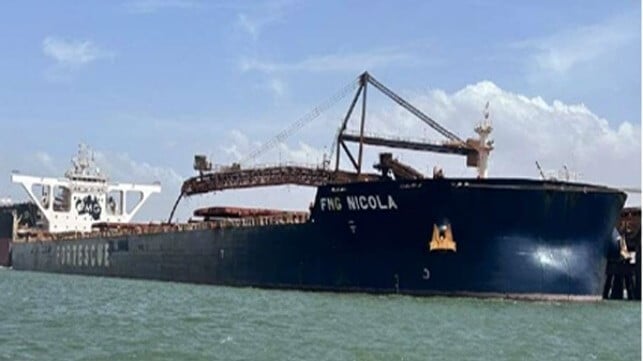Australia Reports on Bulker’s Engine Shut Down in Busy Port Hedland

The Australian Transport Safety Bureau (ATSB) has released its interim report on the incident involving bulk carrier FMG Nicola (260,840 dwt) while departing Port Hedland in Western Australia in February this year. It details how an iron ore carrier nearly caused a major blockade of a busy shipping channel that provides access to the world’s largest bulk export port, and the quick response.
The 327-meter (1,073-foot) Singapore-flagged vessel lost propulsion after her engine shut down due to what investigators have established was a faulty switch monitoring the main engine’s lubricating oil pressure. The ship, fully laden with iron ore, was saved from grounding by tugs and the fast response of the pilot overseeing the outbound trip.
The massive vessel, which was built in 2016 and operates for Australia’s Fortescue Metals Group, could easily have blocked the busy channel that provides access to Port Hedland. It is the world’s largest bulk export port by tonnage, handling over 500 million tonnes of cargo annually. While more than 95 percent of the volume is iron ore, the port also handles exports of salt, manganese, copper concentrates, lithium minerals, and livestock, with more than 6,000 ship movements each year.
Access to Hedland is through the single 22?mile dredged channel that allows only one large ship to pass at a time. For most laden ships, particularly capesize ships such as FMG Nicola, the use of the channel is restricted by tidal conditions. The incident, which happened on February 7, took place within the 10?mile section of the channel that is closest to the port, an area prone to strong tidal flows and with particularly confined spaces.
“A disabled ship can strand on a receding tide as well as blocking the passage of other ships. Depending on departure times, separation between ships and the location of an incident, up to three additional ships could be committed to, or within, the channel and exposed to this hazard at a given time,” said Angus Mitchell, ATSB Chief Commissioner.
Though the investigation is ongoing, ATSB’s interim report provides the details of the incident involving Nicola and a well-organized response. At 0832 local time, the bulker completed loading over 237,000 tonnes of iron ore at its berth in Hedland and was due to depart for Dongjiakou, China, that same afternoon.
By 1348, the ship’s main engine and steering had been tested, and the master-pilot information exchange was completed in preparation for the departure. Four tugs were secured to assist the ship through the port’s single shipping channel. The ship departed at 1412, and 30 minutes later, she was progressing along the channel as planned.
At about 1516, FMG Nicola’s main engine suddenly shut down while she was moving at a speed of 8.3 knots. The pilot quickly informed the tug masters that the ship had lost propulsion and directed them to help keep it in the channel. Luckily, two tugs were still secured, and a third was nearby.
The report highlights that the engine had shut down due to a faulty switch monitoring the main engine’s lubricating oil pressure. Over the next half hour, the ship neared the western and then the eastern side of the channel, before travelling along the channel’s eastern edge as it slowed gradually. The efforts by four tugs prevented the ship from grounding, something that would have resulted in blocking the channel.
The ship’s engineers identified that the engine had shut down as the “main bearing and thrust bearing lubricating oil pressure low” non?cancellable trip had activated. They determined that it had activated due to the faulty operation of the pressure switch. After confirming all engine systems were operating normally, the engine trip lockout system was reset and, at 1523, the engine was restarted at dead slow ahead.
About 35 minutes after the shutdown, the ship had been moved away from the channel side, and its main engine speed had progressively been increased to full ahead, enabling the ship to continue her voyage to China. No damage or injuries occurred during the incident.
ATSB will publish its final report detailing the analysis and findings upon the conclusion of the investigation.
